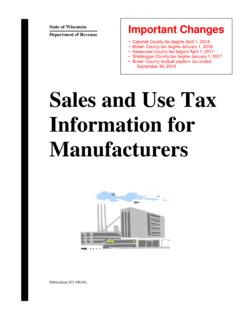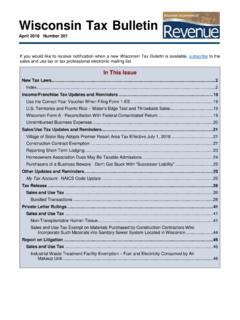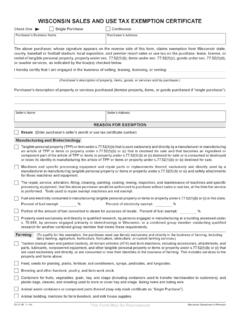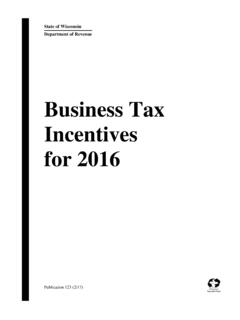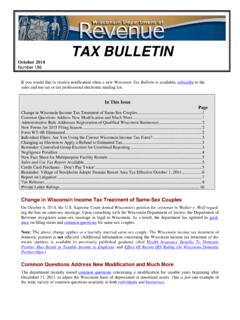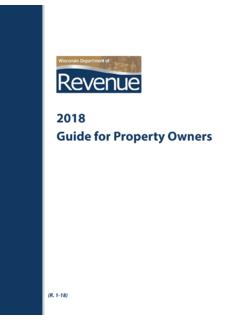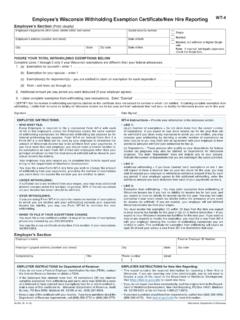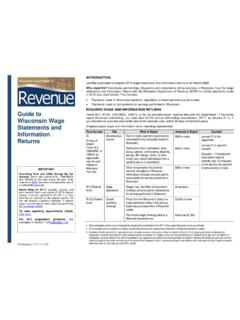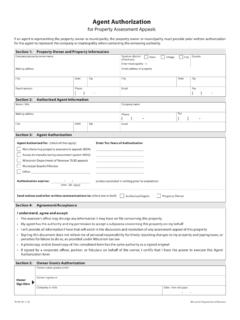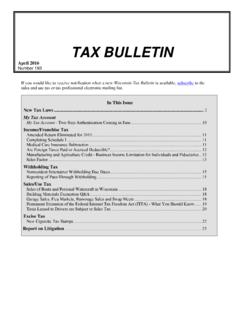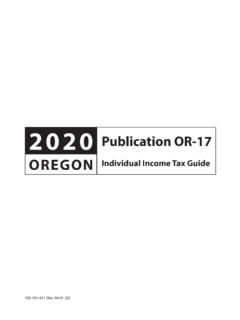Transcription of Pub 103 Reporting Capital Gains and Losses for Wisconsin ...
1 Reporting Capital Gains and Losses for Wisconsin by Individuals, Estates, and Trusts For Use in Preparing 2017 Returns Publicatio103 (01/18)Printed on Recycled Paper Table of Contents Page 1. INTRODUCTION .. 3 2. DEFINITIONS .. 3 A. Short-term and long-term Capital Gains and Losses .. 3 B. Capital loss carryover .. 3 3. DIFFERENCES BETWEEN FEDERAL AND Wisconsin TREATMENT AND HOW TO REPORT .. 3 A. A portion of net Capital gain from assets held more than one year is deductible for Wisconsin .. 4 B. The amount of net Capital loss that can be offset against other income on the Wisconsin return is limited to $500 .. 4 C. Capital gain or loss may be affected when a different election is chosen for federal and Wisconsin purposes .. 5 D. Wisconsin and federal income tax basis of certain assets may differ .. 5 E. Federal Capital Losses incurred while a taxpayer was a nonresident of Wisconsin are not deductible for Wisconsin .
2 7 F. Capital gain or loss from the exchange of a marital property interest between a surviving spouse and a distributee is not taxable or deductible for Wisconsin .. 7 G. Capital gain or loss from a federal S corporation that elects not to be treated as a Wisconsin tax-option corporation is not reportable to Wisconsin .. 7 H. Capital gain treatment not available for Wisconsin purposes for a lump-sum distribution from a retirement plan or profit-sharing plan .. 7 I. Amounts considered long-term Capital gain for federal purposes may be short-term Capital gain for Wisconsin purposes .. 8 J. Gain on the disposition of small business stock .. 8 K. Capital loss carryover may be adjusted when the taxpayer excludes income from discharge of indebtedness .. 8 L. Gain on the sale or disposition of business assets or assets used in farming to a related person .. 8 M. Long-term Capital gain may be deferred if gain reinvested .. 9 N.
3 Exclusion of gain on the sale of an investment in a qualified Wisconsin business .. 9 4. HOW SPOUSES SHOULD REPORT CARRYOVER Losses ON A 2017 RETURN .. 9 A. Spouses file joint return .. 9 B. Spouses file separate returns .. 10 5. ADDITIONAL INFORMATION .. 10 Reporting Capital Gains and Losses Publication 103 Back to Table of Contents 3 1. INTRODUCTION Gains and Losses from sales or other dispositions of Capital assets are reportable for both Wisconsin and federal in-come tax purposes. However, differences exist in the manner in which Wisconsin and federal law treat such income and loss. This publication explains the differences between Wisconsin and federal law in Reporting Capital Gains and Losses on Wisconsin and federal income tax returns. It does not, however, explain all of the details concerning how Capital gain and loss are classified and computed under federal income tax law. For further information on federal law, see internal revenue Service Publication 544, Sales and Other Dispositions of Assets.
4 The amount of Capital gain and loss to include in Wisconsin taxable income is figured on Wisconsin Schedule WD, Capital Gains and Losses . You can get Schedule WD from any Department of revenue office or our website at NOTE: The examples in this publication refer only to the Wisconsin Form 1. Although the differences in Reporting Capital gain income and loss are most likely to affect taxpayers filing Form 1, they can also affect Form 1 NPR filers. A Form 1 NPR filer would make the required adjustments when completing column B of Form 1 NPR. 2. DEFINITIONS A. Short-term and long-term Capital Gains and Losses Gains or Losses resulting from sales or other dispositions of Capital assets are classified as either short-term or long-term. If a Capital asset is owned for more than one year, gain or loss resulting from its disposition is long-term gain or loss.
5 Gain or loss from an asset held for one year or less is considered short-term. B. Capital loss carryover Annual limitations apply as to the amount of net Capital loss which may be deducted against other income in any one taxable year. The entire amount of Capital loss determined for a taxable year may not always be fully de-ductible in such year. The amount of loss exceeding the annual limitation is treated as a carryover loss which may be deducted in subsequent years. Losses may be carried forward for an unlimited time, until completely used. 3. DIFFERENCES BETWEEN FEDERAL AND Wisconsin TREATMENT AND HOW TO REPORT Even though federal adjusted gross income is used as the starting point for computing Wisconsin taxable income, the amounts of Capital gain or loss includible in Wisconsin and federal income may differ for a particular taxable year.
6 Differences can occur both in the year a gain or loss is realized and in carryover years. A difference results in 2017 because a deduction for 30% of the net Capital gain from assets held more than one year is allowable when The publication was revised to improve readability. There are no substantive changes in the text. CAUTION The information in this publication reflects the position of the Wisconsin Department of revenue of laws enacted by the Wisconsin Legislature effective on December 15, 2017. Laws effective after that date, administrative rules, and court decisions may change the interpretations in this publication. Reporting Capital Gains and Losses Publication 103 Back to Table of Contents 4 computing Wisconsin taxable income (60% of net Capital gain on farm assets). Another difference results in 2017 be-cause of the $500 limit on the Wisconsin deduction for Capital Losses . When an individual s Capital gain or loss for Wisconsin differs from the amount includible in federal income, certain adjustments must be made to federal adjusted gross income, the starting point in computing Wisconsin taxable in-come.
7 As A through N on pages 4 through 9 illustrate, adjustments to account for differences between the Wisconsin and federal Capital gain or loss are to be made in one of five ways, depending on the reason such difference exists. The five methods are: By completing Wisconsin Schedule I before federal income is entered on line 1 of Wisconsin Form 1. By completing Wisconsin Schedule WD (Schedule WD of Form 2 for estates and trusts) to compute the amount of Capital gain or loss to be included in Wisconsin taxable income. Any adjustment computed on Schedule WD is reflected on line 3 or 10 of Form 1 (line 4 or 9 of Schedule A, Form 2). By making additions to or subtractions from federal income on lines 3, 4, 10, and 11 of Form 1. These additions and subtractions are called modifications. By completing Wisconsin Schedule T to determine the required adjustment on line 4 or 11 of Form 1 and the re-quired adjustment to use in completing Wisconsin Schedule WD.
8 By redoing the federal return based on the election chosen for Wisconsin . This recomputed or pro forma re-turn is used as the basis for computing Wisconsin taxable income and should be attached to the Wisconsin return when filed. In lieu of a "pro forma" return, the adjustment may be made on Schedule I. These and other differences, along with how to report these differences, are discussed in greater detail in the fol-lowing paragraphs. A. A portion of net Capital gain from assets held more than one year is deductible for Wisconsin Federal treatment: Capital Gains are generally fully taxable for federal purposes. Wisconsin treatment: Wisconsin law generally allows a deduction for 30% of the net Capital gain from assets held more than one year. The deduction is 60% of net long-term Capital gain from farm assets. How to report: Complete Wisconsin Schedule WD.
9 Note Schedule WD does not have to be completed if the only Capital gain or loss is a Capital gain distribution from a mutual fund or real estate investment trust. A subtraction for 30% of the Capital gain distribution may be claimed on line 10 of Form 1. See the Form 1A, line 4, instructions for how to account for this subtraction. B. The amount of net Capital loss that can be offset against other income on the Wisconsin return is limited to $500 Federal treatment: Capital Losses are allowed in full against Capital Gains . If the Losses are more than the Gains , up to $3,000 of the excess loss is allowed as a deduction against other income. Capital Losses in excess of the amount of the allowable loss may be carried over and used in later years. Wisconsin treatment: Capital Losses are allowed in full against Capital Gains . If the Losses are more than the Gains , up to $500 of the excess loss is allowed as a deduction against other income.
10 Capital Losses in excess of the amount of the allowable loss may be carried over and used in later years. Reporting Capital Gains and Losses Publication 103 Back to Table of Contents 5 How to report: Complete Wisconsin Schedule WD. Note: As a result of the difference in the amount of excess loss allowable as a deduction for 2017, a larger capi-tal loss carryover may be available for Wisconsin than for federal in later years. C. Capital gain or loss may be affected when a different election is chosen for federal and Wisconsin purposes Federal treatment: Certain elections are allowed regarding the federal tax treatment of some items. For exam-ple, gain on an installment sale is generally reported as payments are received, but an election is available to report the entire gain in the year of sale. Wisconsin treatment: You may choose a different federal election for Wisconsin and federal tax purposes.
